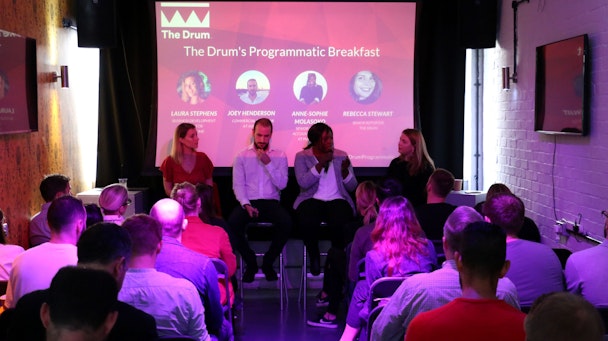The battles programmatic is yet to win in 2019
As programmatic continues to grow as a channel, its strengthening hold on the industry is being held back by transparency, viewability and brand safety issues.

Off Stone Briefing
Over the past year, there have been several landmark developments in the adtech sector, with programmatic tv coming into view and ad budgets moving from mobile web and into apps. Yet, programmatic remains beleaguered, and many marketers continue to be sceptical.
The future of marketing and its current faults was the topic for September’s The Drum Off Stone Briefing. Pulling together a panel from both the advertising side and the publishing side, The Drum sought to try and gauge the future of programmatic and uncover how advertisers, publishers and indeed the entire ecosystem is leveraging programmatic to work better together.
Transparency : a long road ahead
The panel noted how media executives gathered at the Dmexco exhibition in Cologne, Germany, had programmatic transparency on top of their agenda.
It’s been 18 months since Marc Pritchard’s bid to bring transparency to the “murky at best, fraudulent at worst” media supply chain, yet as Avocet’s commercial director, Joey Henderson explained : “there is still a lot of work to be done in that space.”
Discussing innovation and progress, Henderson explained there is “loads of innovation going on in the technical side, with people expanding into new channels and strategies.
"Yet when you speak to advertisers, there are still some underlying concerns around transparency in the industry that aren’t being addressed that well.”
Anne-Sophie Molasoko, the senior demand account manager at Pubnative, added: "A shift in the industry is coming from the advertisers, which influence us on the publisher side to make meaningful measurement and data available." She said that the shift to more meaningful metrics can address knowledge gaps to get better insights.
According to Sublime business director, Laura Stephens : "There has been an uplift in brand studies being attached to a lot of our campaigns. It's more meaningful metrics and seeing how people really feel about the ads that they're receiving."
Rather than measuring post-view conversions, buyers and media sellers need to work together to develop solutions that can provide answers to advertisers tough questions on the length of ad views, and the real output they are getting out of programmatic.
Programmatic Clean-Up on Brand Safety
Now that we have the measurement and are driving out the waste, the next step is to go beyond viewability by looking at things like the context in which the consumer's viewing the ad. So have we found a solution to the issue of brand safety, for instance?
Henderson explained: “It’s a massive challenge, given recent issues like the YouTube scandal. We’ve seen a massive increase in expenditure for blocking verification which is great if you’re a verification filer.
"But for advertisers, it’s a bit difficult to swallow just to say for every programmatic campaign I run, X% of my budget is spent on just blocking verifications, so I’d really like to see more ways that we can clean things up.”
Molasoko added that there is the need to get “better information regarding the quality of the inventory” recognising it as the "publisher's responsibility.”
GDPR : is it really providing consistency?
Though the panel agreed on how the privacy regulation was driving the adtech industry to clean up its act, Henderson questioned whether GDPR has consistent guidelines. “If you go to the top 50 publishers online, you’ll see a lot of different approaches to get consent… there’s not a lot of consistency because as people start to get prosecuted, even if it’s to your competitors, it reflects badly on programmatic as a whole.”
He said he would like to see more initiatives like the transparency consent framework and that “publishers and buyers should work with their partners to help them through this, to ensure we can all get a level playing field and do things that in a consistent, compliant and effective way.”
Future trends
A big theme from Dmexco this year was programmatic tv. After their Time Warner deal in late 2016, AT&T acquired Appnexus in June this year, before launching Xandr last month; moves which have led people to suggest that they are laying the pipework for a really big addressable tv composition. On top of this, Sky stepped closer to making addressable TV ubiquitous, by developing a clear roadmap for when digital TV will have the technology in place to be served programmatically.
Henderson admitted how "excited" the conversations around programmatic tv are getting.
"These huge announcements from AT&T and sky are really exciting for us as there is a massive demand... but the supply hasn't for there yet.
"I think people need to be really patient because broadcast media is a really highly regulated space, so it's not going to happen overnight," and added "when it does happen, it will add a huge amount of value to programmatic as a channel, and programmatic revenue."
For Henderson, the one trend to watch out for is advertising in-housing. "It's already caused a massive disruption in the space, changing the way consultancies interact with brands."
Stephens predicted that all media is going to be available programmatic soon.
"Programmatic is just a way of buying at the end of the day, and it's obviously still in its teenage stage, so it will be interesting to see how that will evolve. Maybe it will combine multimedia's all in one. Over the next year I think all media will be trying to go programmatic to some extent."


